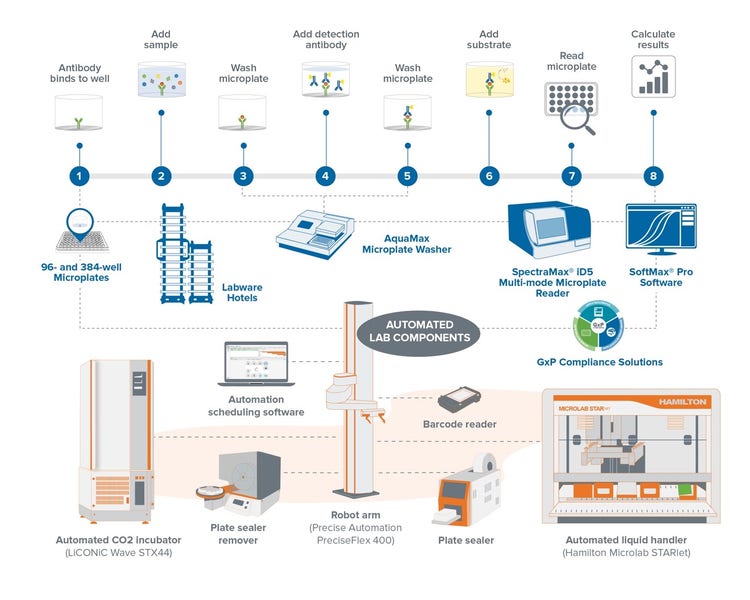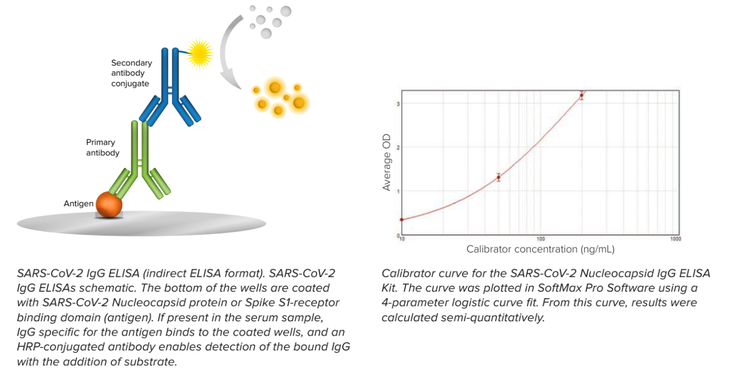
Avantages du test ELISA pour une découverte précise et accélérée de médicaments
Depuis sa découverte il y a près de ans, le dosage d’immunoabsorption enzymatique (ELISA) est devenu la référence dans le domaine des diagnostics et des études d’évaluation des médicaments. À l’aide d’un test ELISA, on peut quantifier une molécule d’intérêt (p. ex., protéine, peptide ou hormone) dans un échantillon liquide en l’immobilisant sur une microplaque, en utilisant des anticorps spécifiques pour fixer cette molécule et en détectant la liaison particulière avec une haute sensibilité. La technique est restée populaire, malgré l’émergence d’autres méthodes comme la cytométrie en flux, en raison de sa spécificité et de sa polyvalence.
Découvrez la discussion détaillée sur la façon dont nos experts utilisent les tests ELISA dans leurs recherches, les avantages spécifiques de ce type de test immunologique, les directions de recherche qui ont été ouvertes grâce à l’utilisation de ELISA, et bien plus encore dans notre podcast récent :
Trois scientifiques accomplis discutent de ce qui distingue le test ELISA et de la manière dont il peut être adapté à la scène de la découverte de médicaments en constante évolution. Principaux points à retenir :



Applications ELISA pour la découverte et le développement de médicaments
Nos trois experts discutent de la façon dont ils utilisent les tests ELISA pour soutenir leurs recherches dans la découverte et le développement de médicaments.
Efficacité des anticorps thérapeutiques contre les cytokines
Pour Kyowa Kirin, le test ELISA est un point de contrôle essentiel pour évaluer l’efficacité des anticorps thérapeutiques contre les cytokines inflammatoires. En mesurant les taux de cytokines, comme l’interféron gamma, l’IL-8 et le TNF-alpha, Dey et ses collègues évaluent la capacité de leurs clones d’anticorps à bloquer la production de ces cytokines. Cela les aide à sélectionner les clones d'anticorps les plus efficaces.
Évaluer les propriétés pharmacocinétiques des anticorps thérapeutiques
Les tests ELISA ont également aidé le Dr Miletic et Mme Dey à évaluer les propriétés pharmacocinétiques des anticorps thérapeutiques. Dans ces études, l’équipe mesure la présence de l’anticorps dans le sang d’un patient à divers moments. Ce processus les aide à déterminer la demi-vie des informations thérapeutiques qui guident leur sélection des clones d'anticorps les plus stables.
Évaluer les taux réduits de p53 dans les cellules knockout
Molecular Devices a démontré la valeur d’une variété de tests ELISA pour un large éventail d’approches de recherche, y compris les expériences knock-out CRISPR . Un exemple est le knock-out du gène p53, qui code pour un suppresseur de tumeur. L’utilisation d’un test ELISA pour évaluer les taux réduits de p53 dans les cellules knockout démontre l’utilité de la méthode pour obtenir des informations sur la fonction génétique, ce qui pourrait finalement conduire au développement de nouvelles thérapies ciblées.
Avantages des tests ELISA par rapport aux autres tests immunologiques
Les trois exemples ci-dessus démontrent la polyvalence des tests ELISA, mais des facteurs supplémentaires les distinguent des autres tests immunologiques.
Cathy Olsen souligne la flexibilité et la sensibilité des tests ELISA : « Les systèmes ELISA peuvent être très sensibles et spécifiques. Ils sont généralement disponibles avec des affichages différents, en fonction de ce qui est nécessaire. Les tests ELISA colorimétriques qui utilisent la détection d'absorbance comme mesure existent depuis des 30 années. Néanmoins, il existe également des lectures fluorescentes et luminescentes qui peuvent vous offrir une meilleure sensibilité et une meilleure plage dynamique. Grâce à sa haute sensibilité, un test ELISA peut détecter les molécules de faible abondance dans l’échantillon. »
Pour Ana Miletic, la spécificité est un attribut essentiel des tests ELISA, ce qui leur permet de faire la distinction entre les protéines étroitement apparentées. Cela dit, le choix de l’anticorps est la clé. « Un test ELISA est aussi bon que les anticorps qu’il contient. La pierre angulaire de tout test ELISA, qui en fait un excellent test, est l’utilisation d’anticorps de haute affinité spécifiques à votre cible d’intérêt. » En d’autres termes, le choix correct d’anticorps permet de s’assurer que l’analyte cible est détecté et minimise les risques de réactivité croisée avec des molécules similaires.
Un autre avantage du test ELISA est sa simplicité, avec seulement plaques, pipettes pour ajouter des échantillons et lecteurs de microplaques nécessaires (un laveur de microplaques peut être ajouté pour faciliter la charge de travail). En dépit de leur conception peu exigeante, les tests ELISA peuvent fournir un large éventail de résultats. Plus important encore, comme la plupart des équipements sont compatibles avec l’automatisation, il est possible de rendre les tests ELISA encore plus accessibles et rationalisés.
Instruments ELISA et solutions de flux de travail d’automatisation
Un flux de travail ELISA automatisé implique plusieurs mises à niveau de la version manuelle, mais l’étendue de l’automatisation dépend en fin de compte des besoins de débit.
Les manipulateurs de liquides automatisés sont très utiles pour la préparation d'échantillons et l'ajout de réactifs, tandis que les bras robotisés peuvent gérer le transfert de plaques entre différentes sections du système. L’association de ces deux éléments signifie qu’il n’est pas nécessaire de pipeter manuellement les réactifs ou de transporter les plaques du banc vers le système de manipulation des liquides, à l’arrière et vers le laveur de plaques et le lecteur. Étant donné que le manipulateur de liquides et le bras robotisé gèrent ces étapes, le chercheur gagne plus de temps pour réaliser des expériences plus intensives.

Deux composants supplémentaires rendent le flux de travail encore plus rationalisé. L’un d’entre eux est le logiciel de planification de l’automatisation qui coordonne le calendrier et la séquence du flux de travail pour obtenir des résultats plus précis et plus opportuns. Les tests cellulaires nécessitent un environnement stable pour les cellules (par ex., 37°C, 5 % de CO2), et un incubateur automatisé est utilisé pour maintenir ces conditions de manière constante.
Néanmoins, Cathy Olsen considère que le lecteur de microplaques est un élément clé du succès de la méthode ELISA automatisée. « La qualité des résultats dépend fortement de la détection précise du signal dans la plaque ELISA. Lorsque vous analysez vos données, vous voulez obtenir des résultats précis et la quantification de cette protéine cible, qui tombe sur le lecteur de plaques. » Le logiciel d’un lecteur de plaques peut offrir une analyse automatisée en utilisant des protocoles configurés pour un test particulier.
Le flux de travail ELISA automatisé a deux résultats positifs. Tout d’abord, comme indiqué précédemment, le temps d’attente augmente significativement, ce qui permet aux chercheurs de réaliser plusieurs tâches à la fois. Plus important encore, il peut réduire les erreurs humaines grâce à une préparation uniforme des échantillons et une procédure de manipulation des liquides bien surveillée.
Ce que l’avenir réserve pour ELISA
De nombreux scientifiques continuent à exploiter les pouvoirs qualitatifs et quantitatifs des tests ELISA, et un rapport d’analyse du marché actuel prévoit que le marché mondial des tests ELISA de recherche passera de 519,4 millions USD en 2022 à 754,38 millions USD d’ici . 2030
Les tests ELISA continuent à servir de référence pour le diagnostic en détectant des antigènes spécifiques dans les fluides corporels, et les professionnels de santé les utilisent dans divers domaines, notamment le test de dépistage du VIH, les tests de grossesse et la détection des maladies infectieuses.
Lors de la récente pandémie de COVID-19, les tests ELISA ont joué un rôle important dans l’élargissement de notre compréhension des mécanismes pathologiques impliqués en permettant la détection d’anticorps contre la protéine spike, l’antigène nucléocapsidique et d’autres protéines virales. En mesurant les anticorps produits en réponse à la vaccination, les chercheurs pourraient également évaluer l’efficacité potentielle d’un vaccin et optimiser sa formulation.

Les tests ELISA peuvent également aider à élucider le mécanisme de travail d’un médicament. Même en présence d’une protéine cible, il faut étudier comment le ciblage d’une protéine spécifique agit. En introduisant une molécule médicamenteuse dans différents types de cellules et en quantifiant les taux de protéines cibles dans ces cellules, les chercheurs peuvent déduire l’impact du médicament sur divers processus cellulaires.
Les travaux futurs doivent porter sur certaines des limites de la méthode ELISA pour étendre son potentiel. Un domaine clé est l'augmentation de la sensibilité pour détecter avec précision de faibles taux d'antigènes dans un échantillon, qui peuvent être obtenus grâce à des techniques d'amplification du signal. De plus, l'optimisation des agents bloquants peut réduire le bruit de fond et empêcher la liaison d'anticorps non spécifiques ou la réactivité croisée avec des antigènes similaires. Enfin, l’ajout du multiplexage est une mise à niveau permettant la quantification simultanée de plusieurs protéines, peptides et petites molécules dans l’échantillon.
Discutez de votre solution ELISA automatisée
L’automatisation n’est pas forcément accablante : il existe de nombreuses options et flexibilités. Nos cinq cellules de travail prêtes à l’emploi pour les flux de travail ELISA offrent des solutions d’automatisation allant de simples capacités de chargement de plaques à des cellules de travail entièrement automatisées plus avancées, et la meilleure partie peut être personnalisée et construite au fil du temps. L’automatisation des tests sur plaques fastidieux augmente le temps d’attente, le débit et la reproductibilité en réduisant le besoin d’un chercheur de s’engager dans des tâches courantes, répétitives et pratiques.
https://share.vidyard.com/watch/Nyr9umn2JZ2JaeMkQGw3jQ
En savoir plus sur nos cellules de travail ELISA ou, lorsque vous êtes prêt à parler à un spécialiste de l’automatisation des flux de travail de votre application, contactez-nous .